Rajasthan Board RBSE Class 12 Economics Chapter 21 Income Output Determination
RBSE Class 12 Economics Chapter 21 Practice Questions
RBSE Class 12 Economics Chapter 21 Multiple Choice Questions
Question 1.
Aggregate demand is equal to :
(a) I + S
(b) C + I
(c) Zero
(d) Infinity
Answer:
(b)
Question 2.
If Marginal Propensity to consume is equal to zero, the value of multiplier would be :
(a) 100
(b) 1
(c) Zero
(d) Infinite
Answer:
(b)
Question 3.
When marginal propensity of saving (MPS) = 0.5, value of multiplier is :
(a) 1
(b) 2
(c) Zero
(d) Infinite
Answer:
(b)
Question 4.
Which of the following is the formula of multiplier :

Answer:
(a)
Question 5.
Who developed the concept of Employment Multiplier :
(a) Richard Goodwin
(b) J.M. Keynes
(c) J.S. Duesenberry
(d) R.F. Kahn
Answer:
(d)
RBSE Class 12 Economics Chapter 21 Very Short Answer Type Questions
Question 1.
What do you mean by multiplier ?
Answer:
Ratio of change in income to the change in investment is called multiplier of change in income. It defines the relation between initial investment and its resultant change in income.
Question 2.
If MPC = 0.9, find the value of multiplier.
Answer:

Question 3.
What do you mean by equilibrium level of income and employment ?
Answer:
The level, where Aggregate Demand equals to the Aggregate Supply, is known as equilibrium level of income and employment.
Question 4.
What are the important components of Aggregate Demand ?
Answer:
There are four important components of aggregate demand :
- Consumption Expenditure
- Investment Expenditure
- Government
- Net export
Question 5.
What are the components of aggregate supply ?
Answer:
In a given time period, all the products available in an economy are called components of aggregate supply.
RBSE Class 12 Economics Chapter 21 Short Answer Type Questions
Question 1.
Explain the working of multiplier with the help of a diagram.
Answer:
In multiplier process, income increases many times upon increase in investment. When investment expenditure increases, then the aggregate demand curve deflects upwards and equilibrium changes and attains equilibrium at high income.
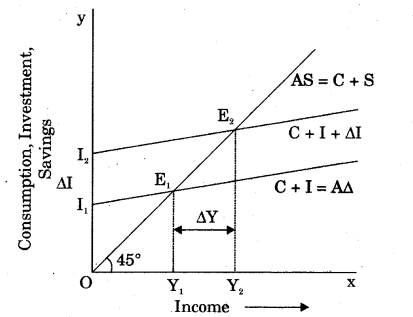
According to the above diagram, when investment increases by I1 I2 = ∆I, then income increases by y1y2 = ∆y.

This is also known as forward process of multiplier.
Question 2.
How is the value of multiplier determined by MPC ?
Answer:
Income of one person is equal to the expenditure of another person. What portion of income shall be increased for consumption is dependent upon the person’s marginal propensity to consume (MPC). If MPC is high, then a large part of income is spent on consumption, which results in many more times increase in the income than investment. Therefore, K (investment multiplier) and MPC have a direct relation.

Question 3.
If MPS = 0.25, find the value of multiplier. Also write its formula.
Answer:
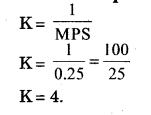
Question 4.
What are the lowest and highest limits of multiplier ?
Answer:
If MPC equals zero, which is a rare situation, then in this situation :

The above two are the highest and lowest limits of multiplier. The value of multiplier lies between 1 and infinity (∞).
Question 5.
What is the practical importance of multiplier ?
Answer:
Multiplier explains the importance of investment in the principle of Income and Employment. National Income increases many times, when the investment increases. It helps in understanding the business cycles. Multiplier is also a base which helps in policy making. Equilibrium can be established between savings and investment with the help of multiplier. It also determines the level of increment needed in investment to achieve the target of full employment.
RBSE Class 12 Economics Chapter 21 Essay Type Questions
Question 1.
Diagrammatically explain the equilibrium level of income with the help of Savings and Investment approach.
Answer:
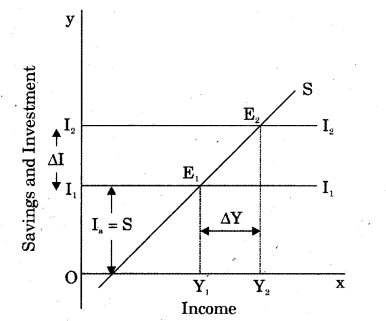
In the above figure, savings and investment curves are initially at equilibrium at E1 The investment initially lies at I1 When investment rises, the investment curve shifts upwards, as shown I2. Here, new equilibrium lies at point E2. Where S = I2. Thus, with increase in investment from I1 to I2, income also increases from to Y2.

Increase in investment increases the equilibrium level of income from E1 to E2.
Question 2.
Explain the equilibrium level of income with the help of diagram and formulae. Ans. Equilibrium level of income is that level where Aggregate Demand = Aggregate Supply (AD = AS). Equilibrium level of income can be obtained by drawing AD and AS curve together, as following:
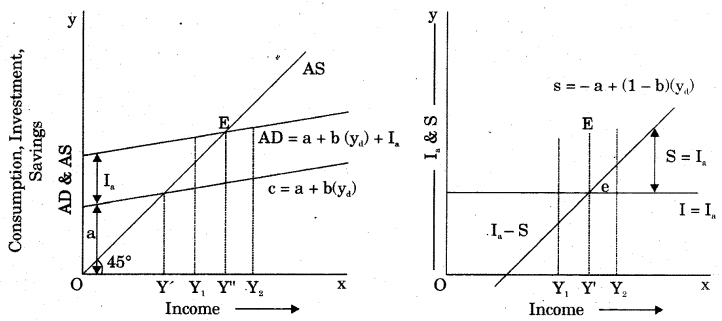
In fig 1, E denotes the equilibrium level of income, here AD = AS.
C + Ia = C + S
Ia = S.
In fig 2, Savings Function, S = – a + (1 – b) Yd has been drawn.
Investment is Autonomous and Constant. Thus, it has been drawn parallel to the X axis. Savings and Investment functions intersect at point E. It lies exactly below the equillibrium point E of fig. 1. At this point, AD insects AS and, is the point of equilibrium. At this point, Ia and S are equal, which shows the equilibrium level of income. We can understand it numerically as follows :
AS = Y
and AD = C + Ia
For Equilibrium level of income,
AS = AD
Y = C + Ia
C = a + bY
As Y = a + bY + Ia
Here b is Marginal Propensity to Consume
1 – b = 1 – MPC = MPS
Y – bY = a + Ia
Y(1 – b) = a + Ia
Y = \(\frac { 1 }{ 1 – b } \) (a + Ia)
This is the equilibrium level of income.
Question 3.
What do you understand by Investment Multiplier ? What is the relationship between Marginal Propensity to Consume and Investment Multiplier ?
Answer:
Investment multiplier : Investment multiplier is the ratio of change in income to the change in investment. It denotes the change in income, which is a result of initial investment.
It is also called Income Multiplier. The concept of multiplier is important for the theory of Income, production and Employment.

Investment Multiplier and Marginal Propensity to Consume: The concept of multiplier is based on the fact that one’s expenditure is the income of another. How much part of the income is increased for consumption depends upon the person’s Marginal Propensity to Consume. If MPC is high, it means that people will spend a large part of income on consumption. It means that increase in income is many more times than the initial increase in investment. Therefore, there is a direct relationship between multiplier (K) and Marginal Propensity to Consume (MPC).
K = \(\frac { 1 }{ 1-MPC } \)
If MPC becomes zero (which is a rare situation) then,
K = \(\frac { 1 }{ 1-0 } \) = 1
If MPC is equal to 1, then
K = \(\frac { 1 }{ 1-1 } \) = \(\frac { 1 }{ 0 } \) = ∞
Both the above stated values are the highest and lowest limits of multiplier, which lies between 1 and ∞.
Value of MPC lies between zero and one.
0 < MPC < 1.
RBSE Class 12 Economics Chapter 21 Other Important Questions – Answers
RBSE Class 12 Economics Chapter 21 Multiple-Choice Questions
Question 1.
How many components does Aggregate Demand have in an open economy ?
(a) Five
(b) Four
(c) Two
(d) Three
Answer:
(b)
Question 2.
On how many components does investment demand depend?
(a) One
(b) Two
(c) Four
(d) Three
Answer:
(b)
Question 3.
Investment demand mainly depends on the change in :
(a) MPC
(b) MPS
(c) Marginal Efficiency of Capital
(d) None of these
Answer:
(c)
Question 4.
Aggregate supply is equal to :
(a) C + S
(b)C – S
(c) S – C
(d) C × S
Answer:
(a)
Question 5.
Investment multiplier was propounded in which year :
(a) 1944
(b) 1930
(c) 1931
(d) 1928
Answer:
(c)
Question 6.
Who propounded the employment multiplier ?
(a) Keynes
(b) J.B. Say
(c) Kahn
(d) Smith
Answer:
(c)
Question 7.
Investment multiplier was proposed by :
(a) Keynes
(b) Kahn
(c) Smith
(d) J.B. Say
Answer:
(a)
Question 8.
Relation between investment multiplier and marginal propensity of savings is :
(a) Direct
(b) Inverse
(c) Equal
(d) Summation.
Answer:
(b)
Question 9.
Higher the value of than what is MPC, the value of multiplier.
(a) Higher
(b) Lower
(c) Equal
(d) None of these
Answer:
(a)
Question 10.
The method where when investment increases, the level of income also increases is called :
(a) Forward Process
(b) Backward Process
(c) Multiplier Process
(d) None of these
Answer:
(a)
RBSE Class 12 Economics Chapter 21 Very Short Answer Type Questions
Question 1.
What is meant by Aggregate Demand ?
Answer:
At a certain level of Income and Employment, the goods and services demanded in an economy in a year is called Aggregate Demand.
Question 2.
State four components of Aggregate Demand.
Answer:
- Consumption Expenditure
- Investment Expenditure
- Government Expenditure
- Net Exports (X-M).
Question 3.
Write the formula of aggregate demand in an open economy.
Answer:
AD = C + I + G + (X – M).
Question 4.
Write the formula of Aggregate Demand in a closed economy.
Answer:
AD = C + I.
Question 5.
Which factors combined to make Aggregate demand ?
Answer:
(i) Consumption demand
(ii) Investment demand.
Question 6.
Consumption demand depends on what factors ?
Answer:
Marginal propensity to Consume and Income.
Question 7.
Investment demand depends on how many factors ?
Answer:
Two factors.
Question 8.
On which two elements investment demand depends ?
Answer:
(a) Marginal Efficiency of Capital
(b) Rate of Interest.
Question 9.
Investment Demand mainly depends on which factor ?
Answer:
On marginal efficiency of capital.
Question 10.
What is meant by marginal efficiency of capital ?
Answer:
It is the expected rate of profit on the investment of capital assets.
Question 11.
What is Aggregate Supply ?
Answer:
It is the monetary value of total salable products in the market.
Question 12.
Write the formula of aggregate supply.
Ans.
AS = C + S.
Question 13.
What are the two sectors in a bi-sector economy ?
Answer:
- Domestic sector
- Production Sector.
Question 14.
An angle of how many degrees is found in the Aggregate Supply curve ?
Answer:
45°.
Question 15.
The straight line of 45° angle in Aggregate Supply curve depends upon which factors ?
Answer:
- Aggregate products
- Monetary form of National income.
Question 16.
If aggregate demand is greater than aggregate supply then what is the situation ?
Answer:
If AD > AS, then the situation is of inflationary gap.
Question 17.
What is the relation between National Income and National Production?
Answer:
They both are the same.
Question 18.
What do you mean by level of equilibrium Income ?
Answer:
It is the level at which Aggregate demand is equal to the Aggregate supply.
Question 19.
Write the formula of equilibrium income.
Answer:

Question 20.
What is meant by ‘a’ in Equity income formula,

Answer:
a = Antonomous consumption.
Question 21.
What is an Inflaction factor Interval ?
Answer:
A situation of full employment, in which, Aggregate Demand is more than the Aggregate Supply, is called inflation factor Interval.
Question 22.
What is Deflation factor Interval ?
Answer:
A situation of full employment, in which Aggregate Demand is less than the Aggregate supply, is called Deflation factor Interval.
Question 23.
How can Inflation Interval be improved ?
Ans.
By decreasing the Aggregate demand.
Question 24.
How can deflation Interval be controlled ?
Answer:
By increasing the Aggregate demand.
Question 25.
When was employment multiplier propounded ?
Answer:
In 1931.
Question 26.
Who propounded the Employment Multiplier ?
Answer:
R. K. Kahn.
Question 27.
Who gave the concept of Investment Multiplier ?
Answer:
J. M. Keynes.
Question 28.
In which year did J. M. Keynes propound the concept of investment multiplier ?
Answer:
In the year 1930.
Question 29.
What is the other name of Investment Multiplier ?
Answer:
Income Multiplier.
Question 30.
Investment Multiplier states the relationship between whom ?
Answer:
It shows the relationship between initial investment and the resultant increase in income.
Question 31.
The value of Investment multiplier is equal to what ?
Answer:
It is equal to the ratio of change in Income and change in Investment.
Question 32.
The concept of multiplier depends upon what ?
Answer:
The expenditure of one person is equal to the Income of another.
Question 33.
What is the relation between investment multiplier and Marginal propensity of consumption?
Answer:
Direct Relation.
Question 34.
What is the relation between investment multiplier and Marginal propensity of savings ?
Answer:
Inverse Relation.
Question 35.
In an economy, on which factor does multiplier value depend upon ?
Answer:
The level of marginal propensity of consumption.
Question 36.
Write the formula for multiplier.
Answer:
K = \(\frac { 1 }{ MPS } \)
Question 37.
If the value of MPS is less, than what will be the value of multiplier ?
Answer:
It will be more.
Question 38.
What is the value of multiplier ?
Ans.
It lies between 1 and infianity.
Question 39.
Where does the equilibrium point lie in an economy ?
Answer:
In an economy, equilibrium lies at the point where Aggregate Demand is equal to Aggregate Supply.
Question 40.
What is forward process multiplier ?
Answer:
If Investment increases, so will the value of Income many times over. This is called
Question 41.
What is backward process multiplier ?
Answer:
When investment decreases, income decreases many more times. This is the backward process multiplier.
RBSE Class 12 Economics Chapter 21 Short Answer Type Questions (SA-I)
Question 1.
Define Aggregate Demand.
Answer:
At a given level of Income and Employment, demand of goods and services in an economy in a year is known as Aggregate Demand.
Question 2.
Explain Aggregate Demand in an open economy.
Answer:
Aggregate Demand is equivalent to the Aggregate Expenditure. It has four components in an open economy :
- Consumption Expenditure
- Investment Expenditure
- Government Expenditure
- Net Export.
Question 3.
In an open economy explain C, I, G, (X- M) in – AD = C + I + G + (X – M).
Answer:
AD = Aggregate demand, C = Consumption Expenditure, I = investment expenditure, G = government expenditure, X – M = net export.
Question 4.
What is Consumption Demand ?
Answer:
Consumption demand is the function of income. It depends upon Marginal Propensity to Consume and income.
Question 5.
On what factors does Investment Demand depend ?
Answer:
Investment Demand depends upon the Marginal Efficiency of Capital and Interest. Here, Rate of Interest remains comparatively constant and does not change in short term.
Question 6.
What is domestic investment demand ?
Answer:
It is the sum total of Gross Domestic Capital formation and stock of unsold goods.
Question 7.
What is meant by Aggregate Supply ?
Answer:
Aggregate supply is also known as total supply of products. A part of Aggregate Supply is sold for consumption, while another part is unsold stock.
Question 8.
Explain Aggregate Supply = C + S.
Answer:
In an economy, Aggregate Supply is the summation of total Consumption Expenditure (C) and Total Savings (S).
Question 9.
Explain the Aggregate demand curve.
Answer:
An economy that has two areas, in one area, lies the domestic sector, in which the demand is for the final consumption, while in Production sector, the demand is for the household Investment. It is also assumed that Investment curve is autonomous.
Question 10.
What is the equilibrium level of Income and Employment ?
Answer:
Where Aggregate demand is equal to the Aggregate Supply, that level of Income and employment is called the equilibrium level of Income and Employment.
Question 11.
State the formulae of Aggregate Income.
Answer:

b = Nature of Marginal Consumption
a = Autonomous Consumption
Ia = Investment.
Question 12.
Graphically represent the Aggregate Demand curve.
Answer:
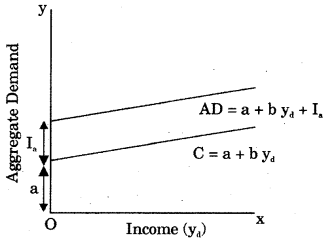
Question 13.
What is the effect on APC and MPC, when Income rises?
Ans.
When Income rises, both APC and MPC decrease, but MPC decreases more than APC.
Question 14.
What is the relationship of Investment multiplier with MPC ?
Answer:
Inverse Relationship.
Question 15.
Graphically represent the Aggregate Supply curve.
Answer:
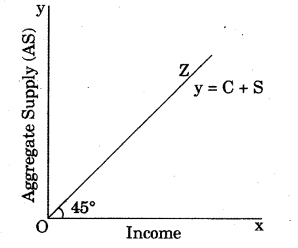
Question 16.
Graphically represent the Aggregate level of Income through the curve of Aggregate Demand and Aggregate Supply.
Answer:
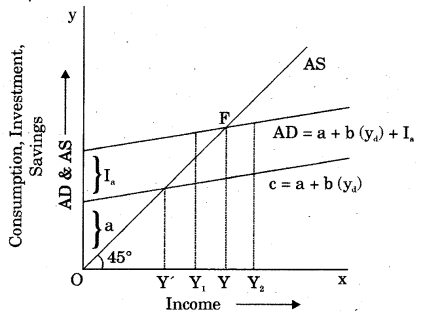
Question 17.
Graphically represent the equilibrium level of Income through investment and saving function curve.
Answer:
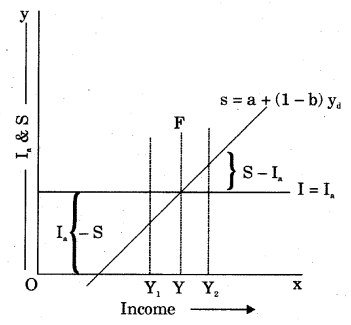
Question 18.
Who propounded Employment multiplier and when ?
Answer:
Employment Multiplier was propounded by R.F. Kahn in 1931.
Question 19.
Who gave the concept of investment multiplier and when ?
Answer:
J. M. Keynes revealed the concept of Investment multiplier in 1930 to get rid of economic depression and financial instability.
Question 20.
Concept of multiplier is important for whom ?
Answer:
It is an important determinant of income creation and employment.
Question 21.
What does the value of multiplier depend upon ?
Answer:
Value of multiplier depends upon the level of marginal propensity to consume. The higher the MPC, the higher will be the value of multiplier.
Question 22.
Explain the formulae of investment
Answer:

It is the ratio of change in income to change in investment.
Question 23.
Explain diagrammatically the process of working of multiplier.
Answer:
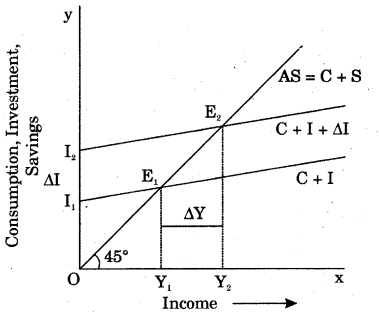
Question 24.
Why does the value of multiplier lie between 1 and ∞ ?
Ans.
Value of MPC lies between 0 and 1, so that the value of multiplier always lies between 1 and ∞.
Question 25.
Where does the equilibrium point lie in an economy ?
Answer:
In an economy, equilibrium lies at the point where aggregate demand is equal to aggregate supply. Here, saving is equal to the investment.
Question 26.
When do we get equilibrium point on investment curve ?
Answer:
When investment increases, the investment curve shifts upwards, and a new equilibrium point E2 is found.
Question 27.
What do you mean by backward process of multiplier ?
Answer:
When investment decreses, income decreases many more times, this is the backward process multiplier.
RBSE Class 12 Economics Chapter 21 Short Answer Type Questions (SA-II)
Question 1.
Explain the Aggregate Demand in an open and closed economy.
Answer:
In an economy, Aggregate Demand is equal to the Aggregate Expenditure, meaning the demand of goods and services in a particular year in an economy at a given level of Income and employment, is called Aggregate Demand. The Aggregate Demand has 4 components in an open economy :
- Consumption Expenditure
- Investment Expenditure
- Government Expenditure
- Net-Exports (X – M)
Therefore, the Aggregrate Demand in on open economy is based on these four components.
Aggregate Demand = C + I + G + (X-M)
But, in a closed economy, Aggregate Demand is equal to (C + I).
Question 2.
What is consumption propensity or consumption function ?
Answer:
According to Prof. Keynes, the part of income which is spent on comsumption is the consumption propensity or consumption function. Thus, the quantity of consumption depends upon the income of a person. When there is a rise in income, consumption also increases, and when the income falls, consumption decreases.
C = F(Y)
Question 3.
On which elements does, mathematically, investment demand depend? Explain.
Answer:
- Investment demand depends upon the marginal efficiency of capital. Here, marginal efficiency of capital refers to the expected rate of profit on capital assets.
- Investment demand also depends upon the Rate of Interest. Rate of interest remains constant and does not change in the short term.
Question 4.
Derive the numerical formula to determine the equilibrium level of income in a two-sector economy.
Answer:
Two-sector economy has two major sectors : Domestic sector and Production sector. Equilibrium income level is that level of income or production where Aggregate Demand equals the aggregate supply, (AD = AS).

Question 5.
In an economy, autonomous investment given is ₹ 400, consumption function = 80 + 0.75 Y, then find the equilibrium income level.
Answer:
Given : Ia = 400
C = 80 + 0.75 Y
AS = Y, AD = C + Ia
We know that, AS = AD
Y = C + Ia
Y = 80 + 0.75 Y + 400
(Y – 0.75 Y) = 480
0.25Y = 480
Y = 480 × \(\frac { 100 }{ 25 } \) = ₹ 1920.
Question 6.
Derive the formula of Equilibrium Income.
Answer:
AS = Y and AD = C + Ia
Equilibrium Income Level:
AS = AD
Y = C + Ia
C = a + bY
Y = a + by + la
(Y) (1 – b) = a + Ia
⇒ Y = \(\frac { 1 }{ 1-b } \) (a + Ia).
Question 7.
Why was the concept of investment multiplier propounded ?
Answer:
During the Great Economic Depression in the decade of 1930, in America and Europe, J. M. Keynes had presented the concept of Investment Multiplier to increase the Aggregate Demand and get rid of depression. This is also called Income Multiplier.
Question 8.
Explain Investment Multiplier.
Answer:
It describes the initial investment and the resultant increase in income due to it. According to this, when an investment is made initially then the rise in income is many more times than investment. The increase in the income in proportion of change in Investment is called investment Multiplier.
Question 9.
On what does the concept of multiplier depend ?
Answer:
It depends on the fact that one’s expenditure is equal to the another’s income. What portion of income will be used for consumption, depends on the Marginal Propensity to Consume.
Question 10.
Which factors reduce the effect of multiplier ?
Answer:
- Propensity to save : The higher will be the people’s tendency of savings, lower will be the value of Multiplier.
- Payment of loans : If income will be used for the repayment of old loans, the value of multiplier will reduce.
- Currency stock: If people stock their currency in either banks or with themselves, it will reduce the consumption and lower the value of multiplier.
Question 11.
Prove that there is a direct relation between Marginal Propensity to Consume and Investment Multiplier.
Answer:
Higher the Marginal Propensity to Consume, it leads to the higher value of multiplier and vice-versa.
Question 12.
Prove that there is an inverse relation between Investment Multiplier and Marginal Propensity to Save.
Answer:
The higher value of marginal propensity to save (MPS) results in a decreased value of investment multiplier and vice-versa.
Question 13.
Draw the AD and AS curve and explain it briefly.
Answer:
Aggregate Demand (AD) is equal to the Consumption Expenditure and Investment Expenditure. When investment expenditure rises, the AD curve shifts upwards and equilibrium is reset at a higher income level.
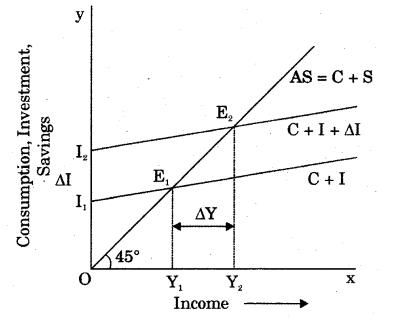
Question 14.
Diagrammatically explain the Savings and Investment method.
Answer:
In figure, savings and investment are set on equilibrium at point E1 in the beginning. Initially, investment is represented as I. When investment rises, investment curve shifts upwards, which is shown as I2.
Here, a new equilibrium point is arrived at E2. Here S = I2, so, the income also rises from Y1 to Y2 when investment increases to I2 from I1.
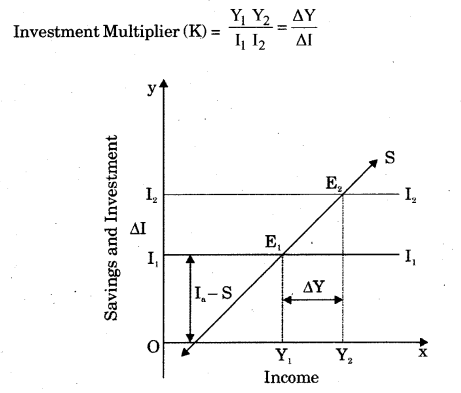
Question 15.
Explain the concept of Inflationary Gap.
Answer:
At the level of full employment, if Aggregate Demand increases, then there will be a rise in marginal price only. This gap of Aggregate Demand is called Inflationary gap, as shown in figure.
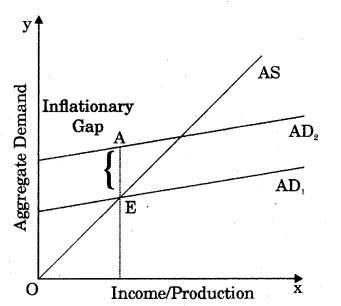
Question 16.
Write the lowest value of investment multiplier.
Answer:
Multiplier can have its lowest value where MPC is zero. MPC cannot be negative, thus, least value of MPC will be O. Then –
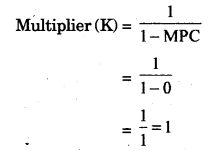
Least value of multiplier is 1.
RBSE Class 12 Economics Chapter 21 Essay Type Questions
Question 1.
Describe diagrammatically, Aggregate Demand in a bi-sector (two sector) economy.
Answer:
Aggregate demand: In a bi-sector economy, demand in the domestic sector is for the final consumption, while in the production sector, demand is for the domestic investment. It is also assumed that investment is Autonomous.
I = Ia (Autonomous Investment)
AD = C + Ia
AD = a + byd + Ia (∵ C = a + byd)
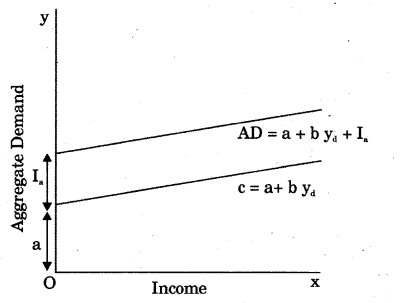
In fig., consumption curve is made, where C = a + byd and consumption is autonomous. It describes the constant consumption level, which remains at the zero income level. By adding Ia to C, we get Aggregate Demand because investment is autonomous. It is added parallel to the Consumption Function.
We can find AD with the help of a table.
Let, Autonomous Consumption (a) = 3000
Autonomous Investment (Ia) = 5000
and MPC = b = 0.7.
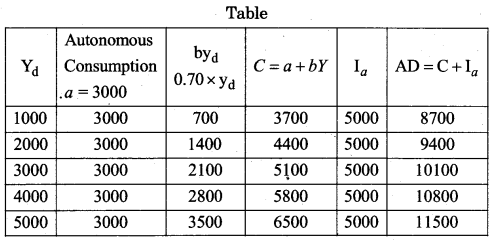
Question 2.
Describe in detail the concept of Investment Multiplier.
Answer:
In the decade of 1930, when there was Great Economic Depression in America and Europe, then Keynes suggested the idea of increasing Aggregate Demand to meet the challenges of the great depression. Along with it, Keynes gave the concept of Keynesian multiplier, which is known as Investment Multiplier or employment/income multiplier. It is an important concept for the theory of Income, Production and Employment.
It defines the relationship between initial investment and the resultant increase in income due to it. The operation of multiplier ensures that a change in investment causes a change in output. Due to this initial investment, income increases many times. The number of times it increases is known as multiplier.
Example : If initial investment is ₹ 200 crores, and due to this, income increases to ₹ 1000 crores, then

Therefore, the value of multiplier is equal to the ratio of change in income to the change in investment.

Here K = Investment multiplier
∆Y = Change in income
∆I = Change in investment
The concept of multiplier is based on the fact that one’s expenditure is another one’s income. How much portion of income is to be increased, depends on Marginal Propensity to Consume.
So, multiplier is directly related to MPC. On the contrary, the higher the Marginal Propensity to Save, lower will be the value of multiplier. Therefore, there is an inverse relationship of multiplier (K) to Marginal Propensity to Save (MPS).
We can understand it as :
If MPC = 0.75

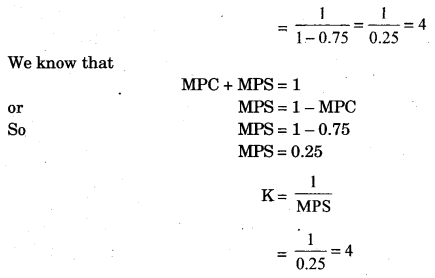
If MPC = 0 (in a rare situation) than is such condition K = \(\frac { 1 }{ 1-0 } \) = 1 when it will be 1 The value of multiplier always lies between 1 and ∞.
RBSE Class 12 Economics Chapter 21 Numerical Questions
Question 1.
If income earned is twice the Autonomous Investment, find the value of value MPC and MPS.
Answer:
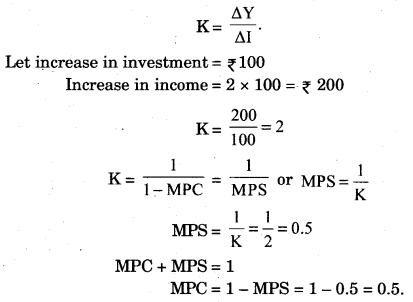
Question 2.
Find the value of multiplier (k), when
(i) MPC = 0.75
(ii) MPS = 0.2
Answer:
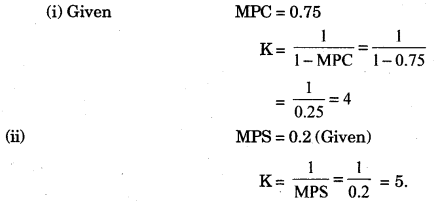
Question 3.
Calculate the change in Income (∆Y), when MPC = 0.50, change in Investment = ₹ 10,000.
Answer:
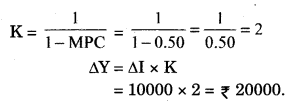
Question 4.
Calculate multiplier from the given table :

Answer:
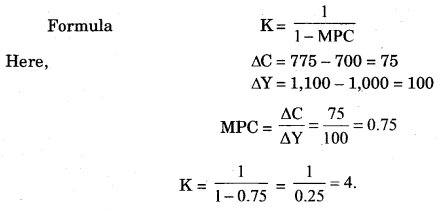
Question 5.
Find the value of multiplier (K)

Answer:
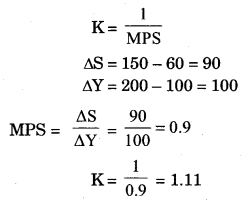
Question 6.
If MPC = 0.75 and investment increases to ₹ 500 crores, find the increase in Consumption and Income.
Answer:
Given MPC = 0.75, ∆I = ₹ 500 crores

Change in Income = K × ∆I = 4 × 500 = ₹ 2000 crores
Change in consumption = AY × MPC = 2000 × 0.75 = ₹ 1,500 crores.
Question 7.
Increase in investment of ₹ 125 crores changes the National Income to ₹ 500 crores. Find MPC.
Answer:
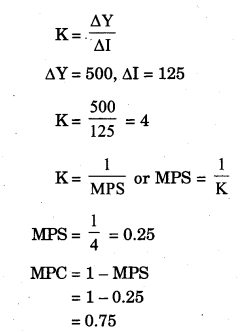
Question 8.
If MPC = 0.75, what will be the value of multiplier and by how much has the investment to be increased to raise the national income to ₹ 600 crore?
Answer:
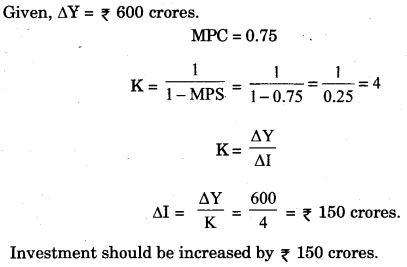
Question 9.
Find the value of multiplier when rise in investment is ₹ 500 crores and half of spare income is always saved.
Answer:
Half of spare income is saved.
MPS = 0.5
K = \(\frac { 1 }{ MPS } \) = \(\frac { 1 }{ 0.5 } \) = 2.
Question 10.
If consumption function (C) = 100 + 0.75Y and investment purchased is ₹ 1,000, then find:
(i) Equilibrium level of national income.
(ii) Consumption at the equilibrium level of National Income.
Answer:
(i) Given that C = 100 + 0.75 Y
1 = 1000
Y = C + 1
Y = 100 + 0.75Y + 1000
Y = 1100 + 0.75Y
(Y – 0.75Y) = 1100
0.25Y = 1100
Y = \(\frac { 1100 }{ 0.25 } \) = ₹ 4400
(ii) Consumption (C) = 100 + 0.75Y
= 100 + 0.75 × 4400
= 100 + 3300 = ₹ 3400.